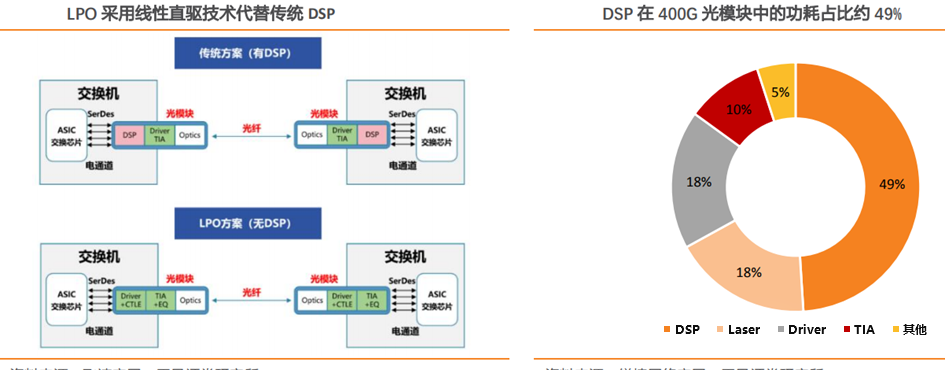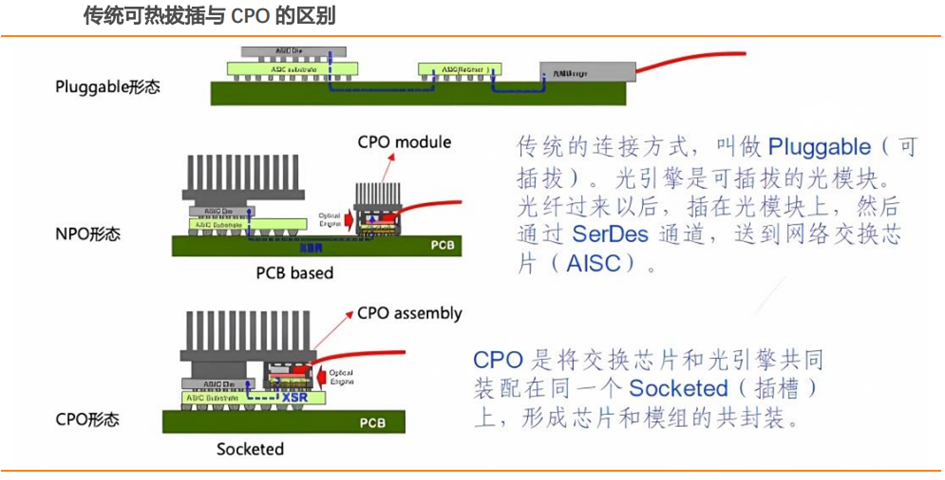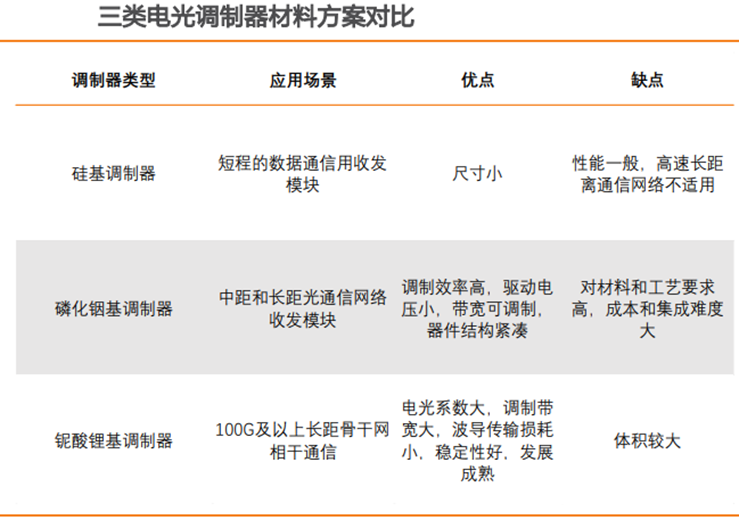In the context of the computing power era, data centers have become major energy consumers. The upgrade of optical module technology is not only about simply doubling the speed, but also needs to address the power consumption and cost issues brought about by high-speed rates. The energy consumption of optical modules accounts for 40% -50% of the energy consumption of data center switching networks. The sharp increase in energy consumption of optical modules has brought enormous pressure to the cost side of data centers, and solving its energy consumption problem has become the key to the current update of optical module technology.
1. LPO
LPO (Linear Drive Pluggable Optics) uses linear drive technology instead of traditional DSP (Digital Signal Processing)/CDR (Clock Data Recovery) chips, which can reduce power consumption and cost. However, the cost is that removing the DSP will increase the system error rate and shorten communication distance. Therefore, LPO technology is only suitable for short distance application scenarios.
Traditional DSP can repair the distortion problem that occurs after high-speed signals are converted between optical and electrical, thereby reducing the impact of distortion on system error rate. However, it has high power consumption and high cost. LPO technology removes DSP and integrates its related functions into the switching chip on the device side, leaving only the Driver (driver chip) and TIA (Trans Impedance Amplifier) with high linearity to compensate for high-speed signals to a certain extent.
The advantages of LPO technology include: 1) Low power consumption: The single channel 100G single mode 800GDR8 and multi-mode 800GSR8 linear drive solutions demonstrated by OFC2023Macom save 70% of multi-mode power consumption and 50% of single-mode power consumption. According to Macom's data, the power consumption of an 800G multimode optical module with DSP functionality can exceed 13W, while the power consumption of an 800G multimode optical module using MacomPuredrive technology is less than 4W. 2) Low latency: Without DSP, the post-processing steps are reduced, resulting in reduced data transmission latency. In Macom's Linear drive scheme, latency can be reduced by 75%. 3) Low cost: After removing DSP from the 800G optical module, the total system cost can be reduced by about 8%. 4) Hot swappable: LPO packaging adopts traditional hot swappable technology for easy maintenance in the later stage.

2. CPO
Co packaged optics (CPO) refers to the assembly of network switching chips and optical modules together in the same slot, forming a co packaging of chips and modules.
Compared with traditional hot swappable technology, the advantages of CPO technology include: 1) low latency and low power consumption: because the optical module and switching chip are in the same package, the signal transmission path is shorter, which can achieve lower latency. In addition, optoelectronic co packaging technology can reduce the power consumption of signal transmission and improve the overall energy efficiency of the system. 2) High bandwidth: Optoelectronic co packaging technology supports high-speed optical communication and can provide larger data transmission bandwidth. 3) Small size: Compared to the traditional separation packaging method of optical modules and electronic chips, optoelectronic co packaging technology can achieve a more compact size, which is beneficial for applications in high-density integrated circuits.

3. Silicon photon technology
Silicon photon technology is a new technology based on silicon and silicon-based substrate materials, utilizing existing CMOS processes for the development and integration of optical devices. The core concept of silicon photon technology is "replacing electricity with light", which uses laser beams to replace electronic signals in data transmission, integrates optical and electronic components into an independent microchip, and improves the connection speed between chips.
Integrating silicon optical materials and devices onto the same silicon substrate to form an integrated photonic device composed of light modulators, detectors, passive waveguide devices, etc. Silicon optical modules do not require ROSA (optical receiving module) or TOSA (optical emitting module) packaging, resulting in smaller volume and quantity of silicon optical devices, and higher integration. 2) Low cost: Compared to traditional discrete devices, the integration degree of silicon optical modules is higher, and packaging and labor costs are reduced; In addition, silicon-based materials have lower costs and can be manufactured in large sizes, which means that the cost of silicon-based chips can be significantly reduced. 3) Compatible with mature CMOS processes: Silicon photon technology can leverage the advantages of mature semiconductor processes in ultra large scale, micro manufacturing, and integration.
4. Thin film lithium niobate
An electro-optic modulator can convert electrical signals into optical signals, thereby achieving modulation of optical signals. Thin film lithium niobate is peeled off from bulk lithium niobate crystals through ion slicing and bonded onto Si wafers with silicon dioxide buffer layers. Compared to other optoelectronic materials such as indium phosphide (limited in cost), silicon light (limited in performance and power consumption), and lithium niobate crystals (limited in size), thin film lithium niobate can achieve ultrafast electro-optic effects and high integration optical waveguides, with excellent characteristics such as large bandwidth, low power consumption, low loss, and small size, and can achieve large-scale wafer manufacturing. Thin film lithium niobate modulator is an optical modulator based on lithium niobate material. Compared with traditional lithium niobate modulators, thin film lithium niobate modulators have significant advantages in device size, electro-optic bandwidth, and integration.

This article is reprinted from the internet. If there is any infringement, please contact us to delete it. Thank you!


















